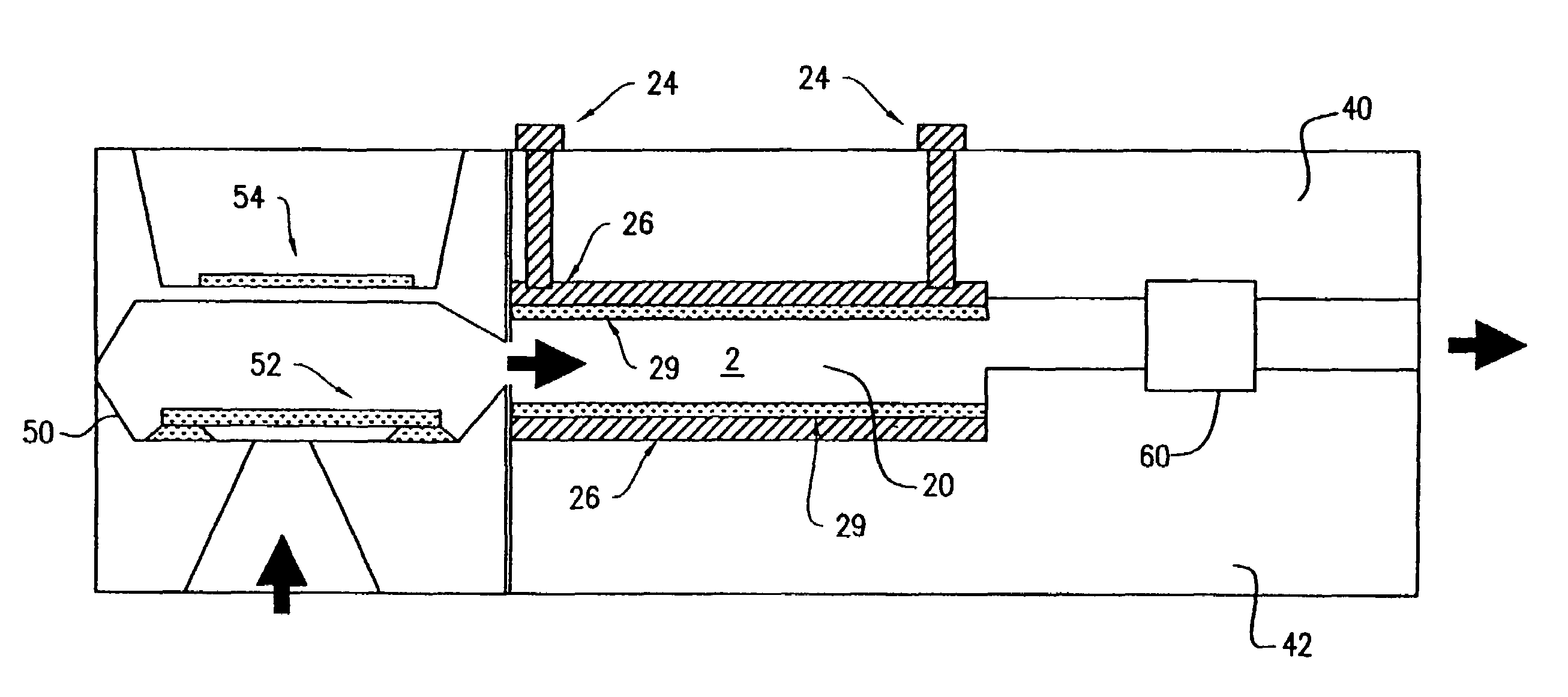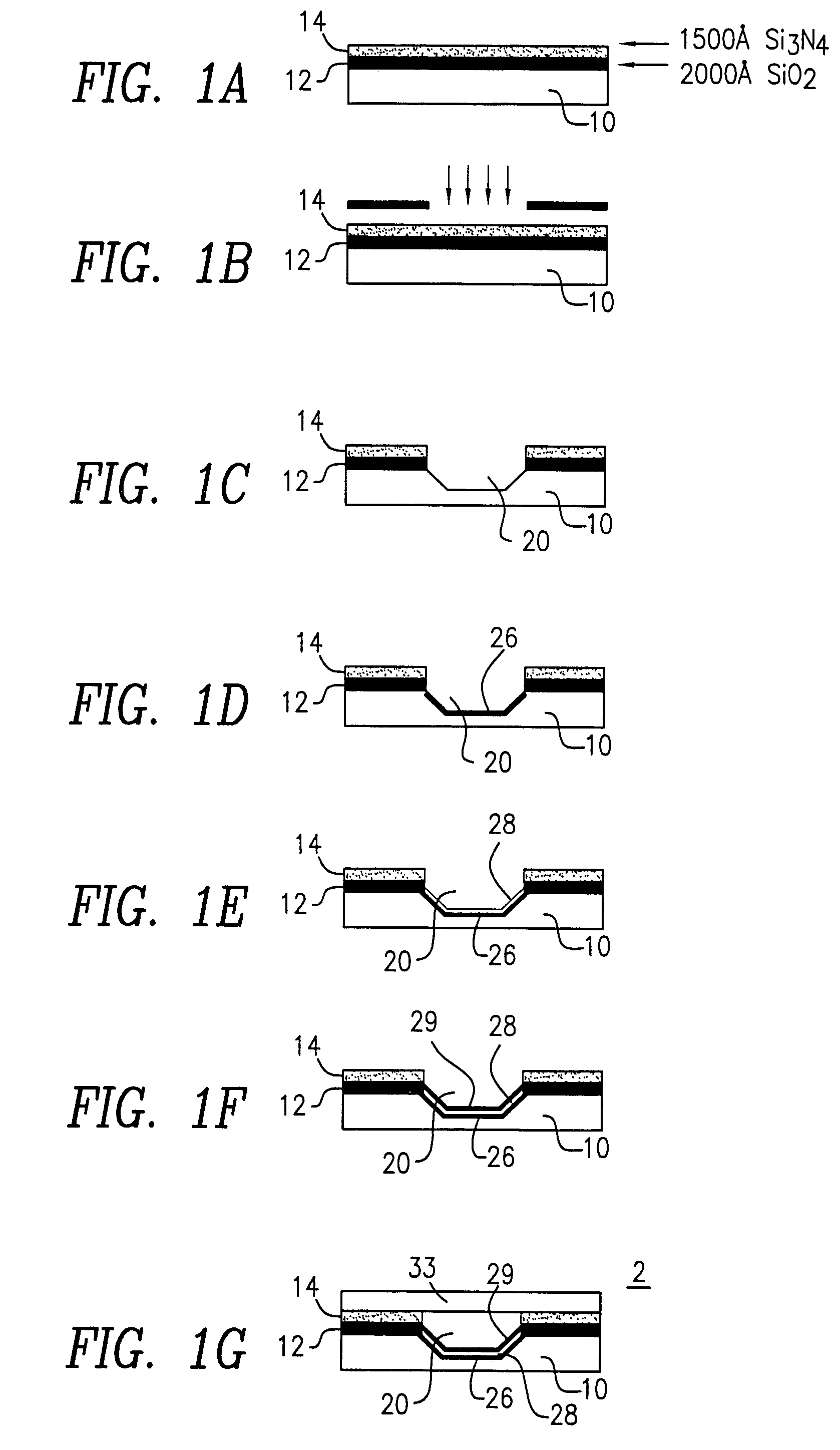Microfabricated microconcentrator for sensors and gas chromatography
- Summary
- Abstract
- Description
- Claims
- Application Information
AI Technical Summary
Benefits of technology
Problems solved by technology
Method used
Image
Examples
experiment 1
[0048]Now referring to FIG. 5, a microconcentrator 2 in accordance with the present invention was employed in conjunction with a pulse heater 65, a conventional flame ionization detector (FID) 70, in this case a SRI Instrument Model 8600 / 9300 portable GC equipped with a FID and a computer 80 for data acquisition. The microconcentrator 2 was cooled by placing it over an ice pack. A commercially available capillary column such as a 0.53 mm ID, 30 m long capillary column (DB-624,J&W Scientific) was employed in some tests. Repeat injections were made under isothermal conditions to generate a series of chromatograms. Standard gases such as air, nitrogen, and hydrogen were purchased from Matheson Gas Co., NJ. Nitrogen was used as the carrier gas, and the flow rate was 7 ml / min. Data acquisition was carried out using the Peaksimple Data System supplied by SRI Instruments. Calibration, qualitative / quantitative analysis, documentation of analytical results, and report output were handled by ...
experiment 2
oconcentrator
[0051]Now referring to FIG. 7, a microconcentrator according to the present invention was put on-line with the sample stream. The gaseous sample containing the analyte was introduced into the detector through the microconcentrator. The analytes were trapped in the polymer film 29 and could be thermally desorbed by electrical heating. The desorption was achieved by resistive heating by a current pulse (1 to 3 sec.). Rapid desorption was essential for producing a sharp concentration pulse to provide high throughput in terms of mass of sample per second. The mode of operation for continuous monitoring was that electrical pulses (injections “I”) were made at fixed intervals of time, and corresponding to each injection, a signal pulse (“C”) was obtained. Continuous monitoring using the microconcentrator 2 was demonstrated by monitoring a stream of organic vapors. As seen in FIG. 7, the microconcentrator 2 generated a series of signal pulses corresponding to a sequence of inj...
experiment 3
[0054]Now referring to FIG. 9, the microconcentrator 2 response as a function of injection interval was studied at 0 and 25 C using toluene as the analyte. As the interval increased, the amount of sample trapped in the microconcentrator 2 increased. However, once the interval equaled tb, the sample began to breakthrough, and the response could not be increased further. The response profile showed a linear increase in response up to tb, followed by a constant response beyond tb. It was seen that the temperature affected microconcentrator 2 operations; lower temperature increase tb.
[0055]Linearity in microconcentrator response was observed as a function of concentration. The concentration range studied here was from 20 to 800 ppm of toluene. Since the amount of sample trapped in the microconcentrator was proportional to the concentration of the stream flowing in, its response was proportional to sample concentration. At a longer injection interval, the larger amount of trapped sample ...
PUM
| Property | Measurement | Unit |
|---|---|---|
| Ratio | aaaaa | aaaaa |
| Sensitivity | aaaaa | aaaaa |
Abstract
Description
Claims
Application Information
 Login to View More
Login to View More - R&D
- Intellectual Property
- Life Sciences
- Materials
- Tech Scout
- Unparalleled Data Quality
- Higher Quality Content
- 60% Fewer Hallucinations
Browse by: Latest US Patents, China's latest patents, Technical Efficacy Thesaurus, Application Domain, Technology Topic, Popular Technical Reports.
© 2025 PatSnap. All rights reserved.Legal|Privacy policy|Modern Slavery Act Transparency Statement|Sitemap|About US| Contact US: help@patsnap.com



